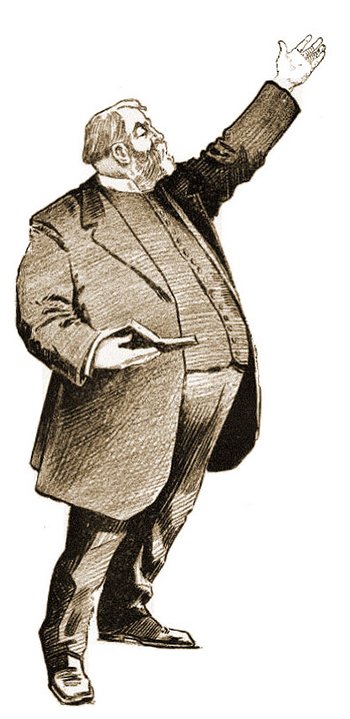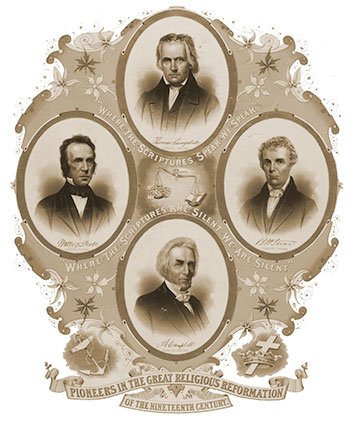1735 New England Revivals, America
January – Jonathan Edwards and the New England Revivals

Jonathan Edwards
Jonathan Edwards, the preacher and scholar who later became a President of Princeton College, was a prominent leader in a revival movement that came to be called the Great Awakening as it spread through the communities of New England and the pioneer settlements in America. From late December 1734 into 1735 an unusually powerful move of God’s Spirit brought revival to Northampton and then spread through New England in the northeast of America. Converts to Christianity reached 50,000 out of a total of 250,000 colonists.
This revival radically altered people’s lives. Edwards noted that:
A great and earnest concern about the great things of religion and the eternal world, became universal in all parts of the town, and among persons of all degrees and all ages; the noise among the dry bones waxed louder and louder; all other talk but about spiritual and eternal things, was soon thrown by….
The minds of people were wonderfully taken off from the world; it was treated among us as a thing of very little consequence. They seemed to follow their worldly business, more as a part of their duty, than from any disposition they had to it….
And the work of conversion was carried on in a most astonishing manner, and increased more and more; souls did as it were come by flocks to Jesus Christ. From day to day, for many months together, might be seen evident instances of sinners brought out of darkness into marvellous light… with a new song of praise to God in their mouths.…
Our public assemblies were then beautiful: the congregation was alive in God’s service, every one earnestly intent on the public worship, every hearer eager to drink in the words of the minister as they came from his mouth; the assembly in general were, from time to time, in tears while the word was preached; some weeping with sorrow and distress, others with joy and love, others with pity and concern for the souls of their neighbours….
Those amongst us who had been formerly converted, were greatly enlivened, and renewed with fresh and extraordinary incomes of the Spirit of God; though some much more than others, according to the measure of the gift of Christ. Many who before had laboured under difficulties about their own state, had now their doubts removed by more satisfying experience, and more clear discoveries of God’s love (Edwards 1835,348).
The characteristics of the New England Revivals
Describing the characteristics of the revival, Edwards said that it gave people:
An extraordinary sense of the awful majesty, greatness and holiness of God, so as sometimes to overwhelm soul and body; a sense of the piercing, all seeing eye of God, so as sometimes to take away the bodily strength; and an extraordinary view of the infinite terribleness of the wrath of God, together with a sense of the ineffable misery of sinners exposed to this wrath. … and … longings after more love to Christ, and greater conformity to him; especially longing after these two things, to be more perfect in humility and adoration.
The flesh and the heart seem often to cry out, lying low before God and adoring him with greater love and humility. … The person felt a great delight in singing praises to God and Jesus Christ, and longing that this present life may be as it were one continued song of praise to God. … Together with living by faith to a great degree, there was a constant and extraordinary distrust of our own strength and wisdom; a great dependence on God for his help … and being restrained from the most horrid sins (Edwards 1835, 377).
Revivals concurrent with the New England Revivals
In 1735, when the New England revival was strong, George Whitefield in England and Howell Harris in Wales were converted. Both were 21 and both ignited revival fires, seeing thousands converted and communities changed. By 1736 Harris began forming his converts into societies, and by 1739 there were nearly 30 such societies.
Whitefield journeyed extensively, visiting Georgia in 1738 (the first of seven journeys to America), then ministered powerfully with Howell Harris in Wales in 1739 and with Jonathan Edwards in New England in 1740, all while in his early twenties.
Around that same time, another man who would soon help spread revival was on his way to America. At the end of 1735, John Wesley sailed to Georgia, an American colony, as an Anglican missionary. A company of Moravian immigrants sailed on that same vessel, and during a terrible storm they all faced the danger of shipwreck. John Wesley wrote about this experience in his journal on Sunday, January 25, 1736:
At seven I went to the Germans. I had long before observed the great seriousness of their behaviour. Of their humility they had given a continual proof by performing those servile offices for the other passengers which none of the English would undertake; for which they desired and would receive no pay, saying, “It was good for their proud hearts,” and “their loving Saviour had done more for them.”
And every day had given them occasion of showing a meekness, which no injury could move. If they were pushed, struck or thrown down, they rose again and went away; but no complaint was found in their mouth.
Here was now an opportunity of trying whether they were delivered from the spirit of fear, as well as from that of pride, anger and revenge. In the midst of the Psalm wherewith their service began, the sea broke over, split the main-sail in pieces, covered the ship and poured in between the decks, as if the great deep had already swallowed us up.
A terrible screaming began among the English. The Germans calmly sung on. I asked one of them afterwards: “Were you not afraid?” He answered, “I thank God, no.” I asked: “But were not your women and children afraid?” He replied mildly: “No, our women and children are not afraid to die” (Greenfield 1927, 35–36).
Back in England in 1738, after his return from a brief and frustrating missionary career in Georgia, John and his brother Charles were challenged by the Moravian missionary, Peter Bohler. In March 1738, John Wesley wrote:
Saturday, 4 March—I found my brother at Oxford, recovering from his pleurisy; and with him Peter Bohler, by whom (in the hand of the great God) I was, on Sunday the 5th, clearly convinced of unbelief, of the want of that faith whereby alone we are saved. Immediately it struck into my mind, “Leave off preaching. How can you preach to others, who have not faith yourself?”
I asked Bohler whether he thought I should leave it off or not. He answered, “By no means.” I asked, “But what can I preach?” He said, “Preach faith till you have it; and then, because you have it, you will preach faith.”
Monday, 6 March—I began preaching this new doctrine, though my soul started back from the work. The first person to whom I offered salvation by faith alone was a prisoner under sentence of death. His name was Clifford. Peter Bohler had many times desired me to speak to him before. But I could not prevail on myself so to do; being still a zealous assertor of the impossibility of a death-bed repentance (Idle 1986, 43).
Both John and Charles were converted in May 1738, Charles first, and John three days later on Wednesday, May 24. He wrote his famous testimony in his journal:
In the evening I went very unwillingly to a society in Alders-gate Street, where one was reading Luther’s preface to the Epistle to the Romans. About a quarter before nine, while he was describing the change which God works in the heart through faith in Christ, I felt my heart strangely warmed. I felt I did trust in Christ, Christ alone, for salvation; and an assurance was given me, that he had taken away my sins, even mine, and saved me from the law of sin and death (Idle 1986,46).
Later that year John Wesley visited the Moravian community at Herrnhut. He admired their zeal and love for the Lord, and he prayed that their kind of Christianity, full of the Holy Spirit, would spread through the earth. Back in England he preached evangelically, gathered converts into religious societies (which were nicknamed Methodists because of his methodical procedures), and continued to relate warmly with the Moravians. Evangelical revival fires began to stir in England and burst into flame the following year.
© Geoff Waugh. Used by permission.
For further research:
The First Great Awakening A comprehensive overview.
On this site:
Introduction
The Great Awakening – Moravians
The Great Awakening – George Whitefield
The Great Awakening – Jonathan Edwards



